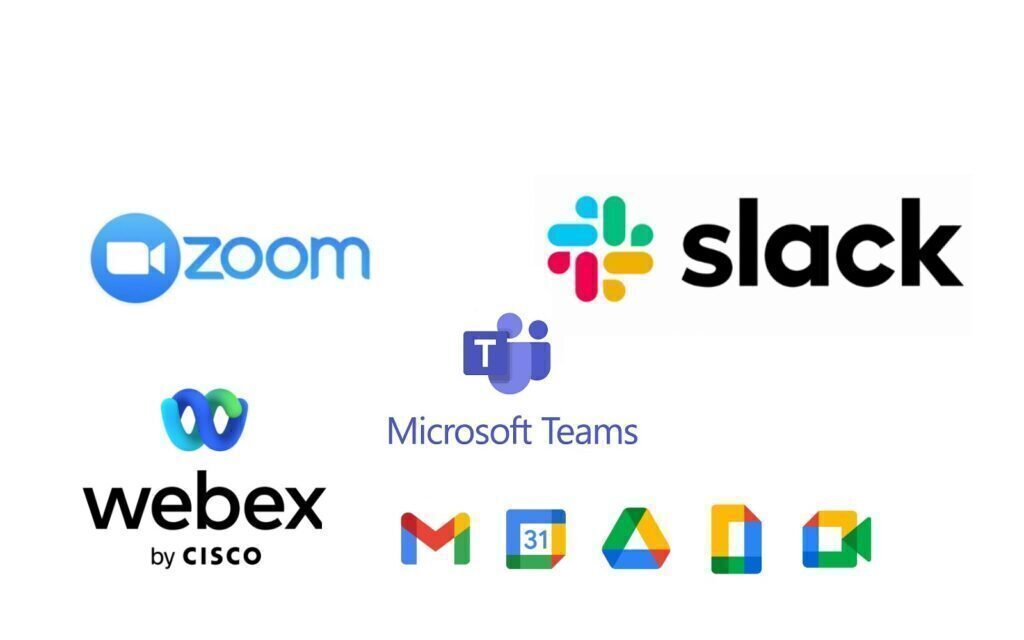Communication is the lifeblood of every organisation in the world. Without staff being able to meet virtually, talk to each other via video and text, share documents, and collaborate with one another on various tasks using just their laptops/smartphones and an internet connection, businesses will simply fall over.
So in the unlikely event that business owners haven’t already made their selection (we did have a global pandemic recently that literally forced people to choose), we’ve put together a list of the five most popular business communication apps/platforms our Google-fu could unearth to help South African business owners decide which one to go with.
Or switch to, in case they’ve already chosen and are regretting that choice.
Google Workspace
- Free tier available
- From R100 per user per month
- Pay annually or per month (annual subscriptions are cheaper)
- Works on mobile
- What you get for the money depends on the subscription tier
Formerly known as G-Suite, Google Workspace is probably the cheapest and best option to go for when it comes to business productivity software. It gives you access to email, online storage, document creation (and collaboration) tools, instant messaging, video conferencing capabilities, and more, all via your browser.
The best part about Google Workspace is you get access to the same business applications at every tier, but things like the amount of storage per user, the number of people you can have on a video meeting, and the kind of security and management options available to you change. Naturally, the more you pay, the more you have access to.
Google Workspace is, in our opinion, right at the top of the list of useful business communication applications, with productivity tools thrown in for good measure. It’s easy to use, only requires a browser and an internet connection, and is surprisingly affordable, even for South Africans suffering the squeeze of a tanking rand.
Visit Google Workspace on the Web
Slack
- Free tier available
- From R140 per user per month
- Pay annually or per month (annual subscriptions are cheaper)
- Works on mobile
- What you get for the money depends on the subscription tier
Slack is a slightly more difficult sell than Google Workspace – it’s really just a messaging platform with audio chat and file-sharing capabilities. It does these very well, of course. It’s just that this is all it does. And for a lot per month per user compared to other options.
Where Slack shines is that it supports plugins for services like Google Drive, Trello, Dropbox, and other useful business productivity and communication applications.
The problem with that, however, is that using Slack with those other services means additional costs, making Slack a pricier option for business communications and productivity. It’s already more expensive on its own than Google Workspace’s cheapest tier, and Workspace offers much more for your cash.
Slack’s free tier is probably the most useful option for most businesses, then. While you’ll have to contend with a limit on the number of messages the free tier allows users to save and the number of apps and integrations it supports, it will still prove useful for companies looking for a basic messaging platform for their staff to use.
Just prepare to need to upgrade to a paid tier in the future as Slack’s limitations become more and more irritating over time.
Microsoft Teams
- Free tier available
- From R71 per user per month
- Pay annually or per month (annual subscriptions are cheaper)
- Works on mobile
- What you get for the money depends on the subscription tier
Microsoft Teams is the most popular communication and collaboration platform available for business users today. It offers video and text chat, file-sharing, and live document collaboration capabilities to make workers’ lives easier. One of Teams’ key appeals is that it has been proven to speed up business processes that involve back-and-forth communications between multiple stakeholders. Processes that, before Teams, took weeks, can now take just days or even hours thanks to the real-time communication and feedback it makes possible.
Teams also integrates with Microsoft’s other productivity applications, giving users access to Teams capabilities inside their familiar Office apps. This allows them to collaborate, communicate, and share files quickly and easily and with a low learning curve.
If you’re a small business, you can get decent use out of Teams, but honestly, you’re probably better off with something less complex and expensive. On the other hand, medium-sized and larger businesses that have already bought into the Microsoft ecosystem – and who want to do things like integrate their phone system into Teams at a later stage – will find a lot to like here.
Visit Microsoft Teams on the Web
Zoom
- Free tier available
- From R238 per user per month
- Pay annually or per month (annual subscriptions are cheaper)
- Works on mobile
- What you get for the money depends on the subscription tier
If all you want from a business communication app is high-quality video conferencing capabilities, shared whiteboarding, and the ability to host webinars and do presentations to an audience, Zoom is a great option.
The paid tiers are not cheap, but if you regularly meet with large groups of people and value crystal-clear video and audio, and you occasionally find yourself wanting to use a virtual whiteboard for brainstorming sessions with a large remote audience, Zoom is brilliant.
While a “free” tier is available, Zoom places limits on things like maximum meeting times (40 minutes, ouch) and the number of allowed participants (100) at the free level to gently motivate you to opt for one of its paid tiers instead.
Other things (paid) Zoom can do include screen-sharing, cloud storage, mail/calendars (just don’t expect Outlook levels of awesome UX design here), the hosting of breakout rooms, and meeting recordings. When hosting meetings or webinars with Zoom, you can rest assured that your audience will feel like they are in the same room with you.
But when it comes to value, Zoom’s focus on video and audio quality hamstrings its value prop somewhat. For just those things it’s amazing; for other business functions like full-featured collaboration and document creation/management, we recommend using (and paying for) something else with it.
Cisco Webex
- Free tier available
- From R280 per user per month
- Pay annually or month-to-month (annual subscriptions are cheaper)
- Works on mobile
- What you get for the money depends on the subscription tier
Cisco Webex is on this list because it consistently comes up in online searches for “the best business communication apps”, but really it’s only here to fill space in this article. Because let’s face it, it’s an enterprise-grade communications platform that’s just too expensive and complicated for small (and even medium-sized) South African businesses.
In brief, Cisco Webex is a cloud-based platform designed for videoconferencing, collaboration, and messaging. It is feature-dense enough to accommodate even the most complex collaboration scenarios for the biggest enterprises and is priced accordingly. The user interface is also not as user-friendly as that of the other solutions on this list.
But if you really must have Webex inside your business, it’s the most robust platform available for virtual meetings, webinars, and online events, able to support webinars and events with up to 100k participants. Just be prepared to pay through your nose for it while your IT department wrestles with its complexities (and curses you for not choosing Google Workspace).
Conclusion
Ignore the others and just get Google Workspace. It’s cheap, easy to use, and offers all of the functions and features that businesses of any size can make use of to get their work done, even when their staff is geographically dispersed across the country or around the world.
Or, you know, you do you. We won’t judge.




